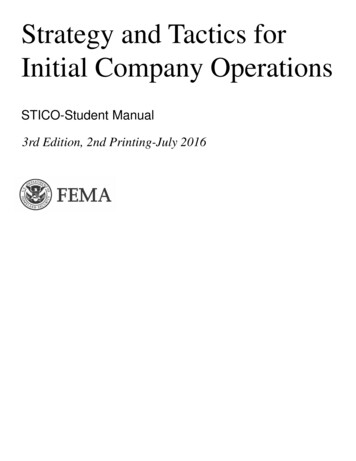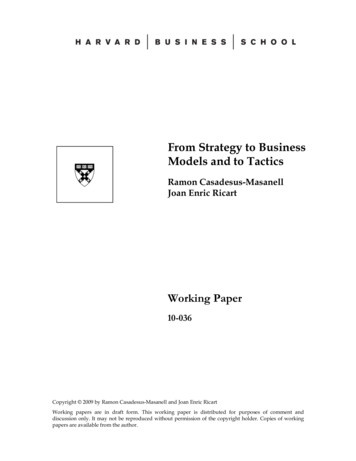
Transcription
Strategy and Tactics forInitial Company OperationsSTICO-Student Manual3rd Edition, 2nd Printing-July 2016
FEMA/USFA/NFASTICO-SMJuly 20163rd Edition, 2nd PrintingStrategy and Tactics for Initial CompanyOperations
Strategy and Tactics forInitial Company OperationsSTICO-Student Manual3rd Edition, 2nd Printing-July 2016This Student Manual may contain material that is copyright protected. USFA has beengranted a license to use this material only for NFA-sponsored course deliveries as part of thecourse materials, and it shall not be duplicated without consent of the copyright holder.States wishing to use these materials as part of state-sponsorship and/or third partieswishing to use these materials must obtain permission to use the copyright material(s) fromthe copyright holder prior to teaching the course.
This page intentionally left blank.
STRATEGY AND TACTICS FOR INITIAL COMPANY OPERATIONSTABLE OF CONTENTSPAGETable of Contents .Acknowledgments .Course Goal .Audience, Scope and Course Purpose .Grading Methodology .Schedule .Firefighter Code of Ethics .A Student Guide to End-of-course Evaluations .UNIT 1:iiivviiviiviiixxixiiiINCIDENT COMMAND SYSTEM AND THE COMMAND SEQUENCE . SM 1-1Appendix: Primary Factors Size-Up ChartUNIT 2:FIRE CONFINEMENT, EXPOSURE PROTECTION, AND FIREEXTINGUISHMENT . SM 2-1UNIT 3:RESCUE, VENTILATION, SUPPORT AND OVERHAUL . SM 3-1UNIT 4:WATER SUPPLY, FIXED FIRE PROTECTION SYSTEMS, ANDSALVAGE . SM 4-1BibliographyAcronymsiii
STRATEGY AND TACTICS FOR INITIAL COMPANY OPERATIONSThis page intentionally left blank.iv
STRATEGY AND TACTICS FOR INITIAL COMPANY OPERATIONSACKNOWLEDGMENTSThe development of any National Fire Academy (NFA) course is a complex process aimed at providing students withthe best possible learning opportunity we can deliver.There are many players in course development, each of whom plays an equally important part in its success. We wantto acknowledge their participation and contribution to this effort and extend our heartfelt thanks for making this qualityproduct.The following people participated in the creation of this course:Russell KuckInstructional Systems SpecialistCurriculum and Instruction BranchU.S. Fire Administration, National Fire AcademyEmmitsburg, MarylandRobert J. BennettTraining SpecialistU.S. Fire Administration, National Fire AcademyEmmitsburg, MarylandTimothy SmithProject ManagerCybermedia Technologies Inc.Reston, VirginiaLea MulliganInstructional DesignerCybermedia Technologies Inc.Reston, VirginiaJerry BallSubject Matter ExpertFire Chief, RetiredCadillac, MichiganRobert SwarthoutSubject Matter ExpertAssistant Chief, RetiredHaymarket, Virginiav
STRATEGY AND TACTICS FOR INITIAL COMPANY OPERATIONSThis page intentionally left blank.vi
STRATEGY AND TACTICS FOR INITIAL COMPANY OPERATIONSCOURSE GOALThe goal of the course is to develop the management skills needed by Company Officers (COs) to accomplish assignedtactics for structure fires.AUDIENCE, SCOPE AND COURSE PURPOSEThe primary target audience for the “Strategy and Tactics for Initial Company Operations” (STICO) course is: Newly promoted COs.Excellent review for experienced COs.Firefighters who may have acting CO responsibilities.Firefighters who want to become COs.The course is designed for newly promoted COs to learn the use and understanding of strategies and tactics and theirimportance in ensuring firefighter safety on the fireground.GRADING METHODOLOGYCourse GradeThe required performance to successfully complete the course is attained by completing the examination with at leasta “C” by answering correctly a minimum of 21 out of 30 questions.The following course grading plan should be used to determine the assigned course grade for each student in the class.Letter GradePoint RangeA90-100B80-89C70-79F69 or lowervii
STRATEGY AND TACTICS FOR INITIAL COMPANY OPERATIONSThis page intentionally left blank.viii
STRATEGY AND TACTICS FOR INITIAL COMPANY OPERATIONSSCHEDULETIMEDAY 1DAY 2Unit 2: Fire Confinement, ExposureProtection, and Fire Extinguishment (cont’d)8:00 - 9:45Introduction, Welcome and AdministrativeUnit 3: Rescue, Ventilation, Support andOverhaul9:45 - 10:00BreakBreakActivity 31: Rescue Tactics10:00 - 10:4510:45 - 11:00Unit 1: Incident Command System and theCommand SequenceUnit 3: Rescue, Ventilation, Support andOverhaul (cont’d)BreakBreakActivity 3.2: Ventilation11:00 - 12:00Unit 1: Incident Command System and theCommand Sequence (cont’d)Unit 3: Rescue, Ventilation, Support andOverhaul (cont’d)Unit 4: Water Supply, Fixed Fire ProtectionSystems, and Salvage12:00 - 1:00LunchUnit 1: Incident Command System and theCommand Sequence (cont’d)1:00 - 2:15Unit 2: Fire Confinement, ExposureProtection, and Fire Extinguishment2:15 - 2:302:30 - 5:00LunchActivity 4.1: Water Supply OperationsUnit 4: Water Supply, Fixed Fire ProtectionSystems, and Salvage (cont’d)BreakBreakActivity 2.1: Fire ConfinementActivity 4.2: SalvageUnit 2: Fire Confinement, ExposureProtection, and Fire Extinguishment (cont’d)Unit 4: Water Supply, Fixed Fire ProtectionSystems, and Salvage (cont’d)Activity 2.2: Fire Confinement and ExposureProtectionFinal Examix
STRATEGY AND TACTICS FOR INITIAL COMPANY OPERATIONSThis page intentionally left blank.x
STRATEGY AND TACTICS FOR INITIAL COMPANY OPERATIONSxi
STRATEGY AND TACTICS FOR INITIAL COMPANY OPERATIONSxii
STRATEGY AND TACTICS FOR INITIAL COMPANY OPERATIONSxiii
This page intentionally left blank.
STRATEGY AND TACTICS FOR INITIAL COMPANY OPERATIONSUNIT 1:INCIDENT COMMAND SYSTEM AND THECOMMAND SEQUENCETERMINAL OBJECTIVEThe students will be able to:1.1Identify an organized approach to safely managing incident scenes.ENABLING OBJECTIVESThe students will be able to:1.1Discuss the Incident Command System (ICS).1.2Analyze the Command Sequence Action Cycle.1.3Identify the types of building construction.1.4Identify how fire behavior factors affect objectives and strategies.
INCIDENT COMMAND SYSTEM AND THE COMMAND SEQUENCEThis page intentionally left blank.SM 1-2
INCIDENT COMMAND SYSTEM AND THE COMMAND SEQUENCEUNIT 1:INCIDENT COMMANDSYSTEM AND THECOMMAND SEQUENCESlide 1-1ENABLING OBJECTIVES Discuss the Incident Command System(ICS). Analyze the Command Sequence ActionCycle. Identify the types of building construction. Identify how fire behavior factors affectobjectives and strategies.Slide 1-2I.MAJOR FUNCTIONS OF THE INCIDENT COMMAND SYSTEMMAJOR FUNCTIONS OF THEINCIDENT COMMAND SYSTEM Command is responsible for overallincident management:––––––Size up.Identify problems.Establish objectives.Determine strategies.Select tactics.Set the Incident Action Plan (IAP).Slide 1-3SM 1-3
INCIDENT COMMAND SYSTEM AND THE COMMAND SEQUENCEA.Command is responsible for overall incident management.B.Responsibilities of command.1.Size up.2.Identify problems.3.Establish objectives.4.Determine strategies.5.Select tactics.6.Set the Incident Action Plan (IAP).MAJOR FUNCTIONS OF THE INCIDENTCOMMAND SYSTEM (cont’d)––––––Develop ICS organization.Manage resources.Coordinate resource activities.Provide for safety.Release information.Coordinate with outside agencies.Slide 1-4SM 1-47.Develop appropriate Incident Command System (ICS) organization.8.Manage resources.9.Coordinate resource activities.10.Provide for safety.11.Release information.12.Coordinate with outside agencies.
INCIDENT COMMAND SYSTEM AND THE COMMAND SEQUENCEEXPANDING ELEMENTS OFINCIDENT COMMAND SYSTEMCOMMANDRICPM-2SAFETYMED UNITREHABSTAGINGE-3FIRE ATTACKGROUPRESCUEGROUPSALVAGEGROUPVENT GROUPE-1E-2E-4T-2T-1E-5Some to assignment, the rest to Staging.Slide 1-5C.Expanding elements of ICS.1.How will they be distributed?2.All to Staging; all to fire; some to each.3.Let’s end with a total of seven units at the scene and look at the ICS charton the slide.EXPANDING ELEMENTS OF INCIDENTCOMMAND SYSTEM (cont’d)COMMANDPM-1RICPM-2MED UNITREHABSTAGINGE-3FIRE ATTACKGROUPE-1FIRE ATTACKGROUPE-4RESCUEGROUPE-2RESCUEGROUPT-2VENT GROUPT-1SALVAGEGROUPE-5What is wrong with the organization?Slide 1-6SM 1-5
INCIDENT COMMAND SYSTEM AND THE COMMAND SEQUENCEEXPANDING ELEMENTS OF INCIDENTCOMMAND SYSTEM (cont’d)COMMANDCOMMANDMED UNITSAFETYRICSAFETYREHABOPERATIONSMED UPDivision Supervisor — directs resources within ageographic area of responsibility.Slide 1-74.Division Supervisor.a.Directs resources within a geographic area of responsibility.EXPANDING ELEMENTS OF INCIDENTCOMMAND SYSTEM (cont’d)COMMANDCOMMANDMED UNITSAFETYRICSAFETYREHABOPERATIONSMED UPIn order to use the geographic terminology effectively,a department must have a method of dividing theincident scene.Slide 1-8b.SM 1-6In order to use the geographic terminology effectively, a departmentmust have a method of dividing the incident scene.
INCIDENT COMMAND SYSTEM AND THE COMMAND SEQUENCEDIVIDING THE INCIDENT An example:– ABCD onDeltaDivisionAlphaSlide 1-9c.Dividing the incident.-Exposures around the outside of the structure.-Exposure buildings or areas.-Floors of a building.DIVIDING THE INCIDENT(cont’d) An example:– Exposure system.ExposureCharlieExposure ExposureBravo 2BravoSTRUCTUREExposure ExposureDeltaDelta 2ExposureAlphaSlide 1-10SM 1-7
INCIDENT COMMAND SYSTEM AND THE COMMAND SEQUENCEDIVIDING THE INCIDENT(cont’d) An example of floors:– Each floor is a Division.Division 5Division 4Division 3Division 2Division 1Basement DivisionSlide 1-11EXPANDING ELEMENTS OF INCIDENTCOMMAND SYSTEM (cont’d)COMMANDCOMMANDMED UNITSAFETYRICSAFETYREHABOPERATIONSMED UPGroup Supervisor — directs resources within afunctional area of responsibility (e.g., Vent, Salvage,Rescue and Water Supply Groups).Slide 1-125.Group Supervisor.a.SM 1-8Directs resources within a functional area of responsibility (e.g.,Vent Group, Salvage Group, Rescue Group, and Water SupplyGroup).
INCIDENT COMMAND SYSTEM AND THE COMMAND SEQUENCEEXPANDING ELEMENTS OF INCIDENTCOMMAND SYSTEM (cont’d) Groups work acrossDivision lines.– Group Supervisorsmust coordinate withthe DivisionSupervisor beforedoing the tasks inthat Division.Slide 1-13b.Groups work across Division lines.c.Divisions and Groups operate on the same level.d.Divisions do not work for Groups, and Groups do not work forDivisions.OPERATE ON THE SAMELEVEL Division Supervisors are responsible forconsidering all problems and solutions forthat geographic area. Groups relieve Divisions of specificfunctional responsibilities.Slide 1-146.When a Division is created, the Division Supervisor is responsible forconsidering all problems and solutions for that geographic area.a.Groups can relieve Divisions of functional responsibilities.b.Group Supervisors are responsible for coordinating with DivisionSupervisors before taking any action that can affect the personnelwithin that Division.SM 1-9
INCIDENT COMMAND SYSTEM AND THE COMMAND SEQUENCEEXPANDING ELEMENTS OF INCIDENTCOMMAND SYSTEM (cont’d)The better way to assign resources.Slide 1-157.A more effective method of implementing ICS with the first alarm wouldbe:a.At initial arrival and assignment of the first-alarm units, begin at theDivision and Group level.b.Plug in additional resources as they arrive.GARDEN APARTMENT FIREPhoto/National Fire Academy (NFA)SM 1-10Slide 1-16
INCIDENT COMMAND SYSTEM AND THE COMMAND SEQUENCEEXPANDING ELEMENTS OF INCIDENTCOMMAND SYSTEM (cont’d)COMMANDCHIEF 1RICE-4SAFETYMED UNITPM-1REHABSTAGINGE-5DIVISION 3EXPOSUREGROUPE-1T-1T-2E-3E-2R-1E-6E-5 CREWVENT GROUPDIVISION 2E-7Slide 1-178.In this example scenario, a fire has broken out at a garden apartmentcomplex.a.Seven engines, two trucks, and a Rescue Unit have arrived; otherunits are responding (approximately 38 personnel or about 10crews).b.Engines — four people; trucks — four people; rescue — two people.c.The attic and third floor are heavily involved (about 50 percent).-Engine 1 or E-1 arrives on the scene.-Safety Officer arrives and assumes safety duties.-E-2 arrives on the scene.-Truck 1 or T-1 arrives on the scene.-Paramedic 1 or PM-1 arrives and is assigned to Rehab.-Chief 1 arrives on the scene.-E-3 arrives on the scene.-E-4 arrives on the scene.-T-2 arrives on the scene.-E-5 arrives on the scene.-E-6 arrives on the scene.SM 1-11
INCIDENT COMMAND SYSTEM AND THE COMMAND SEQUENCEII.-Rescue 1 or R-1 arrives on the scene.-E-7 arrives on the scene.ESTABLISHING INCIDENT OBJECTIVESESTABLISHING INCIDENTOBJECTIVES What is an objective?Slide 1-18ESTABLISHING INCIDENTOBJECTIVES (cont’d) Objectives must be e.Relevant.Time sensitive.Slide 1-19A.SM 1-12Objectives must be Specific, Measurable, Attainable, Relevant and Time ble.4.Relevant.5.Time sensitive.
INCIDENT COMMAND SYSTEM AND THE COMMAND SEQUENCEIDENTIFYING INCIDENTSTRATEGY What is strategy?Slide 1-20IDENTIFYING INCIDENTSTRATEGY (cont’d) Initially for small incidents:– This is the sole responsibility of the IncidentCommander (IC)/Company Officer (CO).Slide 1-216.For small incidents, incident objectives and strategies are the soleresponsibility of the Incident Commander (IC)/Company Officer (CO) andmay take only a few minutes to complete.IDENTIFYING INCIDENTSTRATEGY (cont’d) For large incidents, members of theGeneral Staff will contribute osures.Confine the fire.Extinguish.Overhaul.Ventilate.Salvage (RECEO-VS).Slide 1-22SM 1-13
INCIDENT COMMAND SYSTEM AND THE COMMAND SEQUENCE7.For larger incidents, members of the General Staff (and others) willcontribute to this process.a.Rescue.b.Exposures.c.Confine the fire.d.Extinguish.e.Overhaul.f.Ventilate.g.Salvage (RECEO-VS).TACTICAL DIRECTIONS ANDRESOURCE ASSIGNMENTSWhat are tactics?Slide 1-23TACTICAL DIRECTIONS Tactical directions include determining thetactics necessary for the selected strategyand assigning appropriate resources. Developed around specific operationalperiods.Slide 1-24SM 1-14
INCIDENT COMMAND SYSTEM AND THE COMMAND SEQUENCE8.9.Tactical directions include:a.Determining the tactics and operations necessary for the selectedstrategy.b.Determining and assigning appropriate resources.The tactical directions are developed around specific operational periodsand must have measurable results.TACTICAL DIRECTIONS(cont’d) Large incidents may last for some time. Tactical directions should be realistic. Resource assignments will be made foreach of the specific tasks.Slide 1-2510.For large incidents that may last for some time, there is a limit to what maybe achieved (in terms of accomplishing an incident objective in a singleoperational period).11.Therefore, tactical directions should be stated in terms of accomplishmentsthat can be achieved realistically within the time frame of an operationalperiod.THE COMMAND SEQUENCE Incident priorities. The mission statement of the firedepartment. Life safety. Incident stabilization. Property conservation.Slide 1-26SM 1-15
INCIDENT COMMAND SYSTEM AND THE COMMAND SEQUENCEB.The command sequence.The incident priorities define the mission. All strategies and tactics must beconceived within the boundaries of the mission. The incident priorities are:III.1.Life safety.2.Incident stabilization.3.Property conservation.COMMAND SEQUENCE ACTION CYCLECOMMAND SEQUENCEACTION CYCLE Critical factors of incident operations areoften overlooked (or not given enoughemphasis). This can result in:–––––Poor use of resources.Inappropriate strategies and tactics.Safety problems.High incident costs.Lower effectiveness.Slide 1-27A.Overview.1.2.SM 1-16Critical factors of incident operations are often overlooked (or not givenenough emphasis). This can result in:a.Poor use of resources.b.Inappropriate strategies and tactics.c.Safety problems.d.High incident costs.e.Lower effectiveness.A simple (but thorough) process for planning can be used for small, shortterm events and for long, more complex incidents and events.
INCIDENT COMMAND SYSTEM AND THE COMMAND SEQUENCECOMMAND SEQUENCEACTION CYCLE (cont’d) Consists of six sequential steps:––––––Understanding the situation.Establishing incident objectives.Developing incident strategy.Directing tactical and resource assignments.Implementing the plan.Evaluating the plan.Slide 1-28THE COMMAND SEQUENCE(cont’d)Size-UpSlide 1-293.This process is referred to as the Command Sequence Action Cycle andconsists of six sequential parts:a.Understanding the situation. (Size up the primary factors.)b.Establishing incident objectives.c.Developing incident strategy (activities).d.Directing tactical direction and resource assignments.e.Implementing the plan.f.Evaluating the plan.SM 1-17
INCIDENT COMMAND SYSTEM AND THE COMMAND SEQUENCEUNDERSTANDING THESITUATIONInvolves knowing: What has occurred. If the incident will expand (or get smaller). Present (and future) resource andorganizational needs.Slide 1-304.You must know:a.What has occurred.b.If the incident will get bigger (or smaller).c.Present (and future) resource and organizational needs.THE COMMAND SEQUENCE(cont’d) Size-up.– First step in the process of determining theincident situation.– Assessment of the situation.– Gathering and analyzing cues.– The first action.Slide 1-315.SM 1-18Size-up is the gathering and recognition of information cues.a.The assessment of the situation.b.The first action.
INCIDENT COMMAND SYSTEM AND THE COMMAND SEQUENCETHE COMMAND SEQUENCE(cont’d)Size-UpSlide 1-326.Size-up is the analysis and comparison of incident cues and the basis forproblem identification.a.These problems must be identified to set incident priorities.b.Problem identification is the first outcome.THE COMMAND SEQUENCE(cont’d) Problem identification:– Problem identification is the first outcome. The analysis and comparison of incidentcues are the basis for problemidentification.Slide 1-33SM 1-19
INCIDENT COMMAND SYSTEM AND THE COMMAND SEQUENCETHE COMMAND SEQUENCE(cont’d)Size-UpEstablish ObjectivesDevelop StrategySelect TacticsActionPlanSlide 1-347.The analysis and comparison of incident primary factors and cues are thebasis for problem identification.a.Report of occupants trapped.b.Fire extending to exposures.c.Presence of flammable vapors.THE COMMAND SEQUENCE(cont’d) Incident objectives:– Incident objectives are statements ofguidance and direction.– Objectives are SMART.Slide 1-358.SM 1-20Establishing incident objectives.a.Incident objectives are statements of guidance and direction.b.Objectives are SMART.
INCIDENT COMMAND SYSTEM AND THE COMMAND SEQUENCETHE COMMAND SEQUENCE(cont’d) Determining strategies and selectingtactics.– Strategy is the “what” of the solution.– Tactics are the “how” of the solution.– Designating incident objectives, strategy andtactics is the second action.Slide 1-36THE COMMAND SEQUENCE(cont’d)Size-UpEstablish ObjectivesDevelop StrategySelect TacticsActionPlanSlide 1-379.Determining strategies and selecting tactics.a.Strategy is the “what” of the solution: What must be done to solvethe problem?b.Tactics are the “how” of the solution: They are the specific actionsthat must be performed.c.Designating strategies and tactics is the second action step.SM 1-21
INCIDENT COMMAND SYSTEM AND THE COMMAND SEQUENCETHE COMMAND SEQUENCE(cont’d) IAP:– Comprised of the strategy and tactics,including “who, when and where.”– The IAP is the second outcome.– Objectives explain what can beaccomplished when all allocated resourceshave been deployed efficiently.Slide 1-3810.The IAP delineates “who” takes the action and “when” and “where” theaction takes place.a.The IAP includes the determined strategy and selected tactics.b.The IAP is the second outcome.THE COMMAND SEQUENCE(cont’d)Size-UpImplementationEstablish ObjectivesDevelop StrategySelect TacticsActionPlanSlide 1-39SM 1-22
INCIDENT COMMAND SYSTEM AND THE COMMAND SEQUENCETHE COMMAND SEQUENCE(cont’d) Implementing the IAP:– Directives issued to resources delineatingtheir part of the plan and the “when” and“where.”– Implementation is the third action.Slide 1-4011.Implementing the IAP.a.Resources need to know their part of the plan.b.Directives are issued to the resources delineating their part of theplan, the “when,” and the “where.”c.Implementing the IAP is the third action step.THE COMMAND SEQUENCE(cont’d)– Communicating assignments clearly.– Ensure that assignments are understood.– Obtain timely feedback.Slide 1-41d.Communicating assignments clearly.e.Ensure that assignments are understood.f.Obtain timely feedback.SM 1-23
INCIDENT COMMAND SYSTEM AND THE COMMAND SEQUENCETHE COMMAND SEQUENCE(cont’d)Size-UpTasksEstablish ObjectivesDevelop StrategySelect TacticsImplementationActionPlanSlide 1-42THE COMMAND SEQUENCE(cont’d) Performing tactical operations (tasks):– The tasks that companies and crews performto accomplish the tactics.– Tactics are done at the Division or Grouplevel by those supervisors.Slide 1-43THE COMMAND SEQUENCE(cont’d)Size-UpTasksEstablish ObjectivesDevelop StrategySelect TacticsImplementationActionPlanSlide 1-4412.Performing tactical operations.a.SM 1-24Companies perform specifically learned manual tasks that, whencompleted, achieve or help achieve a tactic.
INCIDENT COMMAND SYSTEM AND THE COMMAND SEQUENCEb.Performing tasks is the third outcome.c.Performance of tactical operations cycles back into the first actionstep: size up.EVALUATING THE PLAN Is the strategy attaining the overallobjectives? Are the appropriate tactics facilitating thestrategy?Slide 1-4513.Evaluating the plan.a.Is the strategy attaining the overall objectives?b.Are appropriate tactics facilitating the strategy?EVALUATING THE PLAN(cont’d) Does the plan need to be modified oradjusted? Continue the size-up, and evaluate theeffectiveness of the IAP. Evaluate every10 minutes.Slide 1-46c.Does the plan need to be modified or adjusted?d.Continue the size-up, and evaluate the effectiveness of the IAP.Evaluate every 10 minutes.SM 1-25
INCIDENT COMMAND SYSTEM AND THE COMMAND SEQUENCEGUIDE TO ACTION PLANNING Makes you think before you act. Helps keep the IC in a proactive mode. Ensures that critical cues are notoverlooked. Can be used at any type of incident. Provides a logical thought process.Slide 1-4714.A guide to action planning.a.Makes you think before you act.b.Helps keep IC in a proactive mode.c.Helps to ensure that critical cues are not overlooked.d.Can be used at any type of incident.e.Provides a logical thought process to follow.ESTABLISHING AN ACTIONPLANWalk-around: hypothetical house fire.Slide 1-48B.SM 1-26Establishing an action plan.
INCIDENT COMMAND SYSTEM AND THE COMMAND SEQUENCEEXAMPLE OF OBJECTIVES Occupied house fire:– Two-story occupied dwelling, 20 feet by 40feet, ordinary construction, fire located inliving room area, first floor, Side Delta, reportof occupants trapped in second floorbedroom, Side Bravo. No externalexposures.Slide 1-49EXAMPLE OF OBJECTIVES(cont’d) Incident objectives:– Objective 1: Provide for the safe removal ofoccupants within 10 minutes.– Objective 2: Contain and control fire toroom/building of origin within 15 minutes.Slide 1-50EXAMPLE OF STRATEGIES Example of strategies for Objective 1:– Strategy 1: Rescue.– Strategy 2: Confine/Extinguish.– Strategy 3: Ventilate.Slide 1-51SM 1-27
INCIDENT COMMAND SYSTEM AND THE COMMAND SEQUENCEEXAMPLE OF TACTICS For Objective 1, the strategy and tacticsmay be:– Rescue/Confine/Extinguish:-- Tactic 1: Deploy a Search and Rescue Group toupper floors.-- Tactic 2: Deploy a hoseline to first floor forstairwell/occupant protection.Slide 1-52EXAMPLE OF TACTICS(cont’d)– Ventilate:-- Tactic 1: Ventilate stairwell (if possible) and SideBravo to support occupant removal.Slide 1-53EXAMPLE OF STRATEGIES(cont’d) Example of strategies for Objective 2:– Strategy 1: Confine/Extinguish.– Strategy 2: Ventilate.– Strategy 3: Salvage.Slide 1-54SM 1-28
INCIDENT COMMAND SYSTEM AND THE COMMAND SEQUENCEEXAMPLE OF TACTICS(cont’d) For Objective 2, the strategy and tacticsmay be:– Confine/Extinguish:-- Tactic 1: Deploy a hoseline to first floor, SideDelta for confinement/extinguishment.-- Tactic 2: Deploy a hoseline to second floor, SideDelta for interior exposure protection.Slide 1-55EXAMPLE OF TACTICS(cont’d)– Ventilate:-- Tactic 1: vertical ventilation of roof apertures andhorizontal ventilation on the first and secondfloors.Slide 1-56EXAMPLE OF TACTICS(cont’d)– Salvage:-- Tactic 1: positive ventilation with proper use offans.-- Tactic 2: use of salvage covers and control ofwater runoff.Slide 1-57SM 1-29
INCIDENT COMMAND SYSTEM AND THE COMMAND SEQUENCEIV.BUILDING CONSTRUCTIONBUILDING CONSTRUCTIONCLASSIFICATIONS Understanding the strengths, concernsand specific characteristics ofconstruction types is critical. As structural elements becomeweakened, gravity will take over and pullthe building down.Slide 1-58There are five different building construction classifications. Each has inherent strengthsand weaknesses (i.e., pros and cons). These characteristics affect the objectives, strategiesand tactics used during an incident.BUILDING CONSTRUCTIONCLASSIFICATIONS (cont’d) Type I: fire-resistive.Type II: noncombustible.Type III: ordinary construction.Type IV: heavy timber.Type V: wood frame.Slide 1-59A.SM 1-30As a refresher, the building construction classifications are:1.Type I: fire-resistive.2.Type II: noncombustible.3.Type III: ordinary.4.Type IV: heavy timber.5.Type V: wood frame.
INCIDENT COMMAND SYSTEM AND THE COMMAND SEQUENCETYPE I: FIRE-RESISTIVECONSTRUCTIONWhat is the effect of fire-resistiveconstruction on objectives?Slide 1-60B.Type I: fire-resistive construction.TYPE I: FIRE-RESISTIVECONSTRUCTION (cont’d)Photo/NFASlide 1-611.Office buildings of this type of construction often contain large open areaswith heavy fire loading.2.Ventilation is a significant problem.3.Operations are extremely labor intensive, demanding extensive resources.SM 1-31
INCIDENT COMMAND SYSTEM AND THE COMMAND SEQUENCETYPE I: FIRE-RESISTIVECONSTRUCTION (cont’d)Photo/NFAPhoto/NFAPhoto/NFASlide 1-62TYPE I: FIRE-RESISTIVECONSTRUCTION (cont’d)Photo/NFASlide 1-63SPRAY-ON FIREPROOFINGPhoto/NFASlide 1-644.SM 1-32Structural steel is not exposed. It is often protected by encasing, sprayed-onprotection or membrane ceilings.
INCIDENT COMMAND SYSTEM AND THE COMMAND SEQUENCEENCLOSED STAIRSPhoto/NFASlide 1-655.All vertical openings, such as stairwells and shafts, are protected usingapproved doors.TYPE II: NONCOMBUSTIBLECONSTRUCTIONWhat effect would noncombustibleconstruction have on your strategy?Slide 1-66C.Type II: noncombustible construction.SM 1-33
INCIDENT COMMAND SYSTEM AND THE COMMAND SEQUENCETYPE II: NONCOMBUSTIBLECONSTRUCTION (cont’d)Photo/NFASlide 1-67TYPE II: NONCOMBUSTIBLECONSTRUCTION (cont’d)Photo/NFASlide 1-68TYPE II: NONCOMBUSTIBLECONSTRUCTION (cont’d)Photo/NFASlide 1-69SM 1-341.Structural steel is usually exposed.2.The structural steel members will retain heat, causing them to become goodheat conductors.
INCIDENT COMMAND SYSTEM AND THE COMMAND SEQUENCETYPE III: ORDINARYCONSTRUCTIONWhat is the effect of ordinary construction onobjectives?Slide 1-70D.Type III: ordinary construction.TYPE III: ORDINARYCONSTRUCTION (cont’d)Photo/NFASlide 1-71TYPE III: ORDINARYCONSTRUCTION (cont’d)Photo/NFASlide 1-72SM 1-35
INCIDENT COMMAND SYSTEM AND THE COMMAND SEQUENCETYPE III: ORDINARYCONSTRUCTION e 1-73TYPE III: ORDINARY CONSTRUCTION —NEW STRIP MALLPhoto/NFASlide 1-74SM 1-361.Ordinary construction buildings may have common walls and commonfloor sockets, allowing for rapid fire spread.2.Parapet walls, cornices, overhangs, loads on walls, signs and marquees, orother heavy items must be considered for the safety of those workingunderneath.
INCIDENT COMMAND SYSTEM AND THE COMMAND SEQUENCETYPE IV: HEAVY TIMBERCONSTRUCTION What is the effect of heavy timberconstruction on objectives/strategies?Slide 1-75E.Type IV: heavy timber construction.1.Usually masonry (noncombustible) exterior walls and substantial timberconstruction.2.Wood beams, as used in open ceiling structures.TYPE IV: HEAVY TIMBERCONSTRUCTION (cont’d) Portions of walls arenoncombustible orlimited combustiblematerials (usuallymasonry loadbearing walls). Interior membersare solid orlaminated wood.Photo/NFASlide 1-76SM 1-37
INCIDENT COMMAND SYSTEM AND THE COMMAND SEQUENCETYPE IV: HEAVY TIMBERCONSTRUCTION (cont’d) A modern styleof Type IVconstructions ismasonry wallstructures(churches
STICO-Student Manual. 3rd Edition, 2nd Printing-July 2016. Strategy and Tactics










